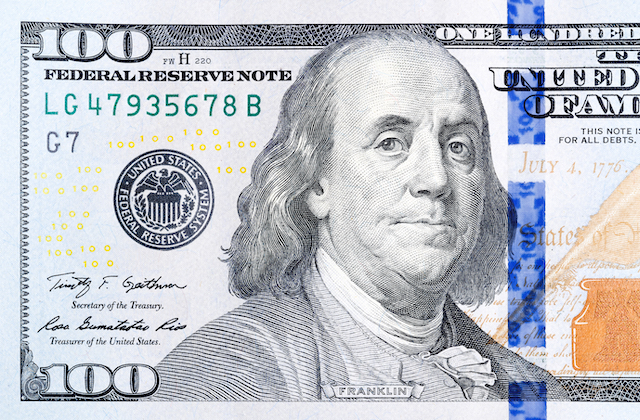Missing the Point – More questions about Mayor Scott’s Campaign Contributions and his Relationship with Venable Law
In my previous op/ed, we talked about the optics of certain January 2023 contributions to Mayor Brandon Scott’s campaign committee at a time when the Mayor was negotiating the sale of Baltimore’s conduit system to BG&E.
Certainly, the timing of these contributions might just be coincidental, but it could also be construed as indicative of a problematic relationship between money and the behavior of an elected official.
Turns out that optically questionable behavior involving the Mayor and campaign contributions is nothing new.
This op/ed is about three campaign committees and the 2018 primary election for Governor…
- “People for Brandon M. Scott,” founded March 25, 2011.
- “Jim Shea for Maryland,” founded March 16, 2017.
- The “Shea-Scott for Maryland Slate,” founded April 10, 2018.
James Shea, a prominent attorney and former Chairman of the Venable law firm, was running for Governor. Brandon Scott, who was then-Councilman for Baltimore’s District 2, was campaigning with Mr. Shea for the position of Lt. Governor. A “slate” is different than an individual candidate committee in that it is a committee for two or more candidates running together and, as such, is subject to somewhat different campaign contribution limits than a campaign committee for a single candidate.
I have no idea what Mr. Shea’s expectations may have been when he filed as a candidate for Governor, but he received only 8.3% of the Democratic primary vote. Ben Jealous won with 39.6%. Rush Baker, the former County Executive of Prince George’s County, came in second with 29.3%.
As his running mate, Mr. Shea’s choice of Brandon Scott is “interesting.” Brandon Scott is now Mayor of Baltimore, but was only a 34-year-old, a second-term City Councilman when the June 26, 2018 primary was held. The question is, why did someone as accomplished and astute as James Shea select a running mate who was virtually unknown outside of Baltimore City and had no experience or other qualifications to govern Maryland?
Well, one reason might be to give the Shea ticket some racial balance. Mr. Shea is White. Mr. Scott is African American. Maybe Mr. Shea and his advisors thought that Mr. Scott would bring substantial Black votes from Baltimore with him, but that didn’t happen. In any case, there were certainly other African American men and women in Baltimore who would have done much more for the Shea ticket, both politically and then administratively should Mr. Shea have been elected.
Maybe Mr. Shea thought that Jealous and Baker, both African Americans, would split the Black vote for Governor, allowing him to squeeze out a victory supported by mostly Democratic voters interested in having a White candidate go up against popular Republican incumbent Larry Hogan. Clearly, that strategy – and who knows what the Shea political team was really thinking – didn’t work out either.
And here’s a third, all-encompassing possible explanation. It’s that Brandon Scott may have met not just one, but four important criteria to be James Shea’s running mate.
- Brandon Scott is Black.
- He’s from Baltimore and was reasonably well known among the city’s African American voters.
- He was available. In other words, no other more qualified Baltimore City African American was willing to run with Mr. Shea in what would likely be an unsuccessful primary or general election effort.
- Brandon Scott was relatively inexperienced, politically out-classed and possibly even intimated by the Shea organization and advisors – and willing to do whatever he was told.
Brandon Scott may have had no special qualifications to be Lt. Governor, but he was a convenient political choice.
As you know, in Maryland the legal limit for contributions to a single candidate during a given election cycle is $6000. Not $6000 per year, but per election cycle which is four years long. The election cycle that included the June 26, 2018 primary began on January 1, 2015 and ran through December 31, 2018. With those dates in mind, let’s look at contributions to Brandon Scott’s campaign committee that occurred after it was announced that he would be running for Lt. Governor with James Shea on the top of the ticket.
So, Mr. Scott agrees to run and, together with Mr. Shea, they establish the “Shea-Scott Maryland Slate” on April 10, 2018, just two and half months ahead of the June 26, 2018 Democratic primary.
The table below shows selected contributions made by people listing their employer as either “Venable” or “Venable LLP” in reports filed by the Shea and Scott campaign committees. Contribution amounts are the total made by the contributor during the period indicated. For those making more than one contribution, the date shown is for the most recent of the two or more contributions made.
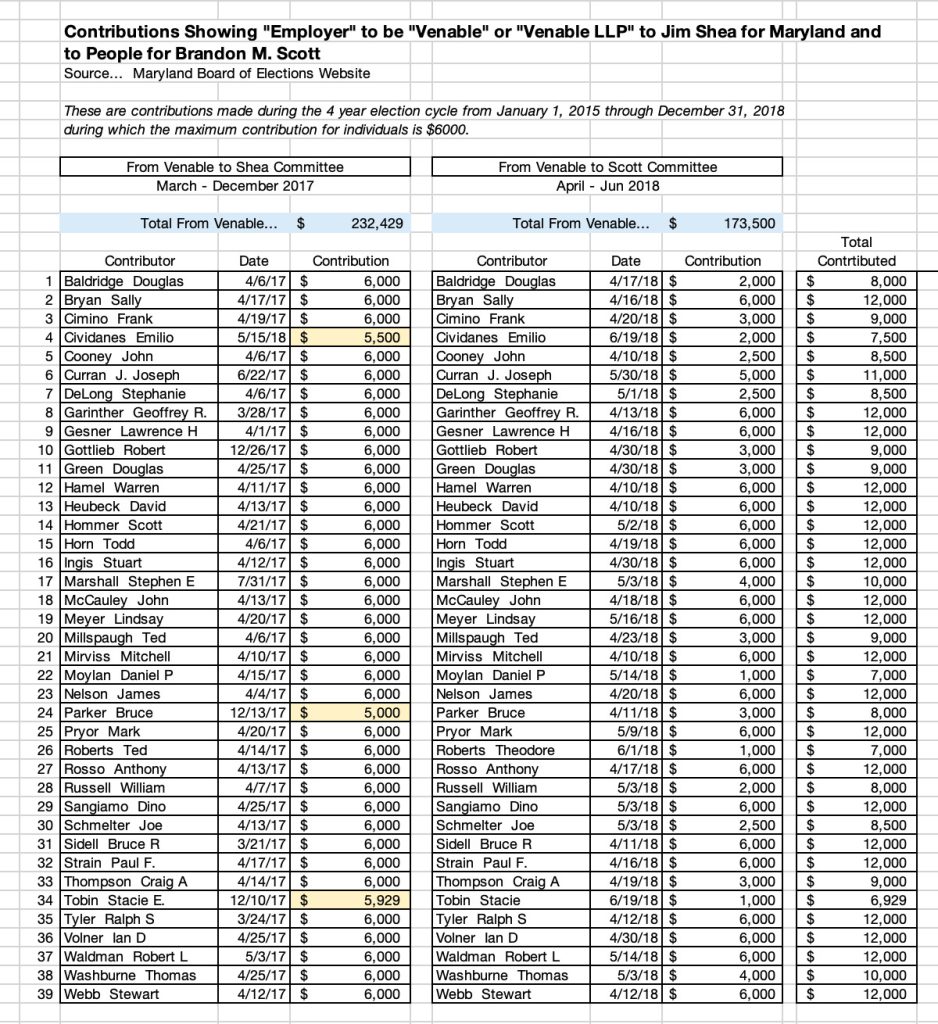
The three columns on the left show 39 contributions to Jim Shea for Maryland in 2017 totaling $232,429. Notice that 36 of these contributions were for the $6000 maximum. The other three were for $5000, $5500 and $5929 and were close to the legal limit, but weren’t maxed out yet.
Now, look at the three columns to the right which show contributions by the same 39 people to People for Brandon Scott in April, May, and June of 2018, just before the June 26 primary. It’s reasonable to assume that, this close to the primary, the Shea campaign realized that it needed more money for television and other campaign marketing.
“So, why not just have these same Venable people contribute directly to Jim Shea for Maryland or to the Shea-Scott for Maryland Slate?”
Because doing so would have caused them to exceed the $6000 legal limit for campaign contributions during a four-year election cycle. So, they gave the additional money the Shea campaign needed to Mayor Scott’s campaign committee.
And then the People for Brandon M. Scott committee contributed the money to the Shea-Scott for Maryland Slate committee. It could all be coincidental of course, but the optics are such that the subsequent contributions to the Slate committee by the Scott committee appear to be on behalf of the 39 Venable contributors who were already up against their $6000 limits.
This next table shows one hundred percent of the contributions made to the Shea-Scott for Maryland Slate. As you can see, the slate had only thirteen receipts. There are some large contributions from Jim Shea’s campaign committee. And some small-dollar refunds from The Campaign Group, a campaign marketing firm, all dated after the June 26 primary.
That leaves three transfers from People for Brandon M. Scott that I’ve highlighted, all of them in June 2018 before the primary. What you’re seeing is money, contributions made by the 39 Venable other contributors that was not spent by the Mayor’s campaign committee, but were subsequently transferred to the Shea-Scott for Maryland Slate.
Forwarding those funds had the effect – intentionally or not – of allowing those contributors to circumvent state election law limiting individual campaign contributions to $6000 per election cycle. Figuratively speaking, we’re talking about the completely legal laundering of campaign contributions that would otherwise exceed the statutory limit.
Technically, there’s nothing wrong with what I’m describing. It’s just proof of yet another shortcoming, another loophole in our laws, which are intended to keep the influence of money on our elections within limits the Legislature considers reasonable.
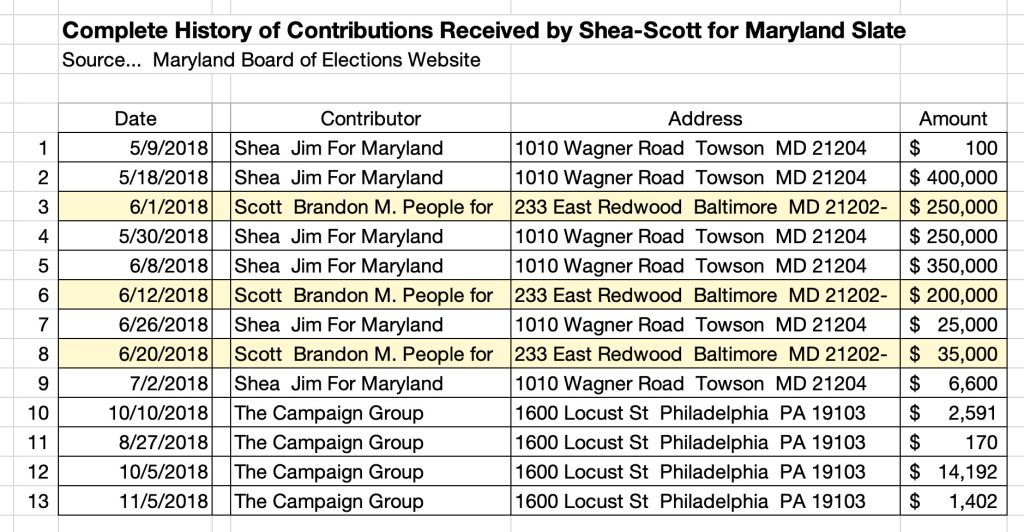
Here’s a very helpful chart, published by the Maryland Board of Elections, that shows “Contributions and Transfer Limits.”
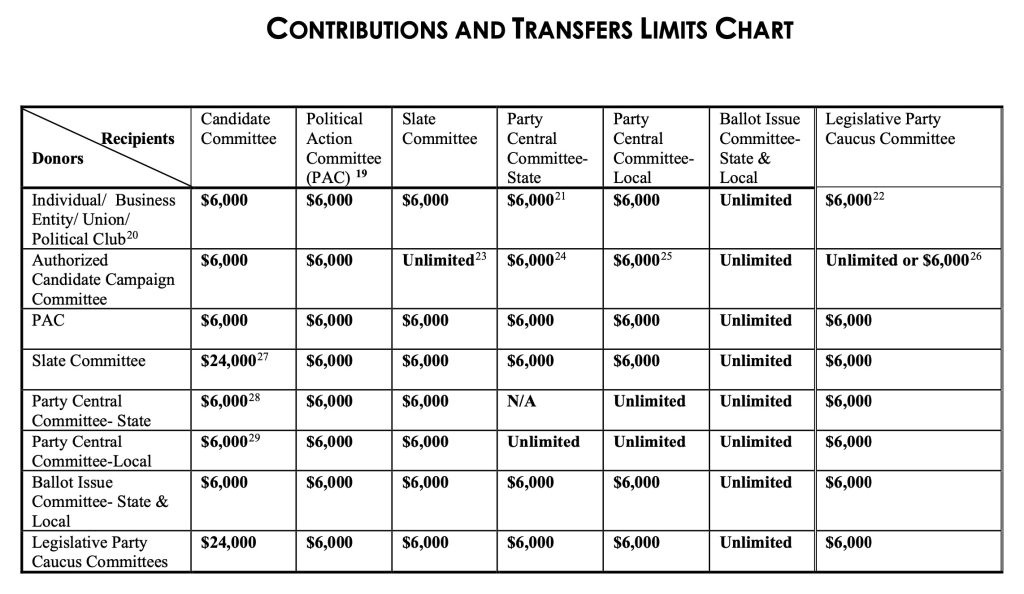
Notice that individual “Donors” are limited to contributing $6000 to all “Recipients” except ballot issue committees, while contributions by individual candidate campaign committees to slate committees are unlimited. And now you have a likely reason why individual campaign contributions to the Shea campaign – in excess of the $6000 limit – were directed through Mayor Scott’s campaign committee. It’s because the Scott committee could contribute any amount of money, however large or often, to a slate committee, no questions asked – even if that large transfer was funded by any number of smaller campaign contributions by individuals or companies.
One other thing… Go back to the table showing contributions to the Shea-Scott for Maryland slate. Note again the three contributions from People for Brandon M. Scott in the amounts of $250,000 on June 1, $200,000 on June 12, and another $35,000 on June 20. Let’s see if we can confirm the sources of those funds.
The complete campaign finance reports to which I am going to refer are all accessible through the Maryland Board of Elections website.
The June 1 $250,000 – a substantial portion of which came from individual Venable contributions – was listed as a “Transfers Out” on page 7 of the People for Brandon M. Scott campaign finance report for the period May 16 through June 10. It’s included in the total $253,000 that you can see below in Part 3 of the committee’s filing.
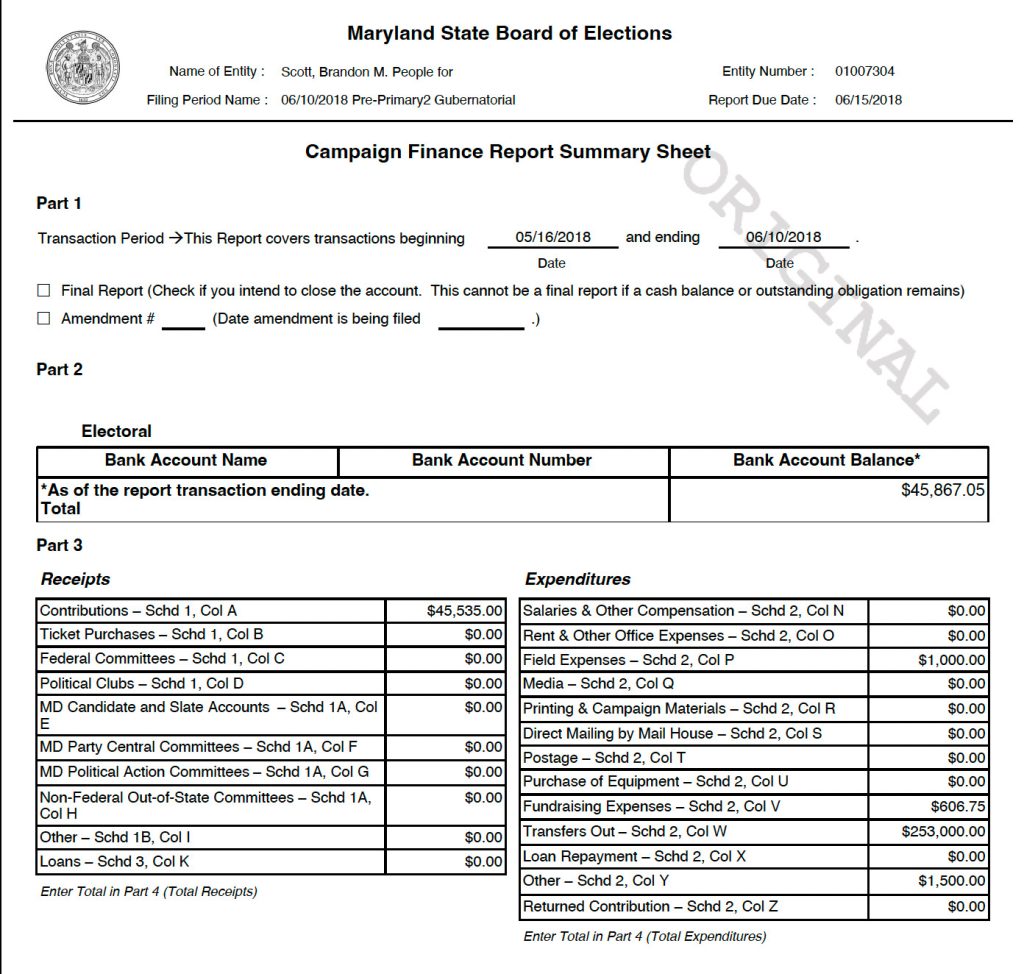
The June 20 $35,000 is confirmed on page 4 of the People for Brandon M. Scott campaign finance report for the period June 11 through August 21, 2018 where it was classified as “Field Expenses” in the $38,100 showing in Part 3 of the committee’s filing.
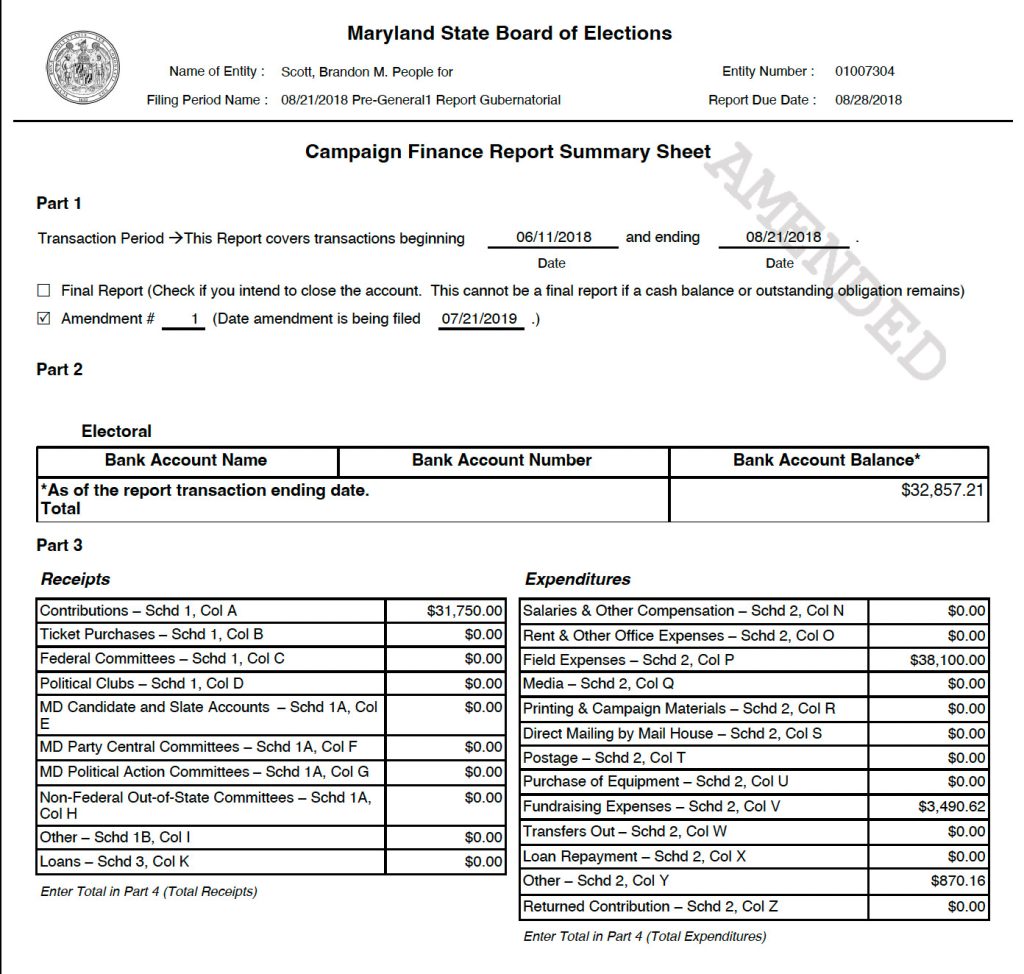
Unfortunately, the same report for June 11 through August 21, 2018 makes no mention of the $200,000, dated June 12, 2018 that is showing on the Shea-Scott for Maryland Slate list of contributions received – not as “Field Expenses” or “
Transfers Out” or anywhere else on the People for Brandon M. Scott report. Nor was there enough money on hand – only $32,857 – to cover the $200,000 transfer.
“It’s probably just an innocent clerical error.”
Of course, but the question is, why didn’t the Board of Elections computer pick it up and require that either the Scott or Shea-Scott Slate committee amend its filing? From where, exactly, did the $200,000 come from? If it did come from the People for Brandon M. Scott committee, where did the Scott committee get the money to fund that transfer?
At the very least, if the Legislature is serious about campaign financing reform, there is an urgent need for a very significant increase in funding for the Board of Elections, with special instructions to improve computerized analysis of campaign contributions and expenditures.

Les Cohen is a long-term Marylander, having grown up in Annapolis. Professionally, he writes and edits materials for business and political clients from his base of operations in Columbia, Maryland. He has a Ph.D. in Urban and Regional Economics. Leave a comment or feel free to send him an email to [email protected].

